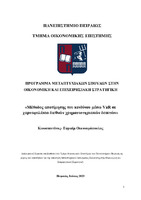Μέθοδος αποτίμησης του κινδύνου μέσω VaR σε χαρτοφυλάκιο διεθνών χρηματιστηριακών δεικτών
VaR risk assessment method for a portfolio of international stock market indices

View/
Keywords
Value at Risk ; Χρηματοοικονομική ανάλυση ; Χαρτοφυλάκιο ; Κίνδυνος αγοράς ; Μοντέλα προβλέψεωνAbstract
The complexity and uncertainty of the global financial system has resulted in the loss of large amounts of money from businesses and banks. In the last two decades, the markets have had to face the 2008 Lehman Brothers bankruptcy, the 2011 European countries' debt crisis , the 2020 health crisis and the cessation of commercial activity and finally the energy crisis due to the Russia-Ukraine war. Financial institutions in order to be able to deal effectively with the market risks turned to the formulation of tools to predict and manage the various risks. Value at Risk (VaR) is one of the most widely used risk management methods as it expresses the estimated maximum loss of a particular investment over a certain period of time and level of confidence. This paper examines the basic methods of VaR calculation. The theoretical framework of the paper will analyse the risks that financial institutions are required to deal with in the current economic environment. At the same time, this paper will examine the definition of VaR, its importance as well as its benefits and weaknesses when using it. The main methods of its calculation will be studied, Variance - Covariance Method the Historical Simulation Method and the Monte Carlo Simulation Method. Finally, we will present the practical application of these methods in a portfolio which will include the indices of the HA & DAX.


